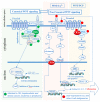Targeting Casein Kinase 1 (CK1) in Hematological Cancers
- PMID: 33261128
- PMCID: PMC7730698
- DOI: 10.3390/ijms21239026
Targeting Casein Kinase 1 (CK1) in Hematological Cancers
Abstract
The casein kinase 1 enzymes (CK1) form a family of serine/threonine kinases with seven CK1 isoforms identified in humans. The most important substrates of CK1 kinases are proteins that act in the regulatory nodes essential for tumorigenesis of hematological malignancies. Among those, the most important are the functions of CK1s in the regulation of Wnt pathways, cell proliferation, apoptosis and autophagy. In this review we summarize the recent developments in the understanding of biology and therapeutic potential of the inhibition of CK1 isoforms in the pathogenesis of chronic lymphocytic leukemia (CLL), other non-Hodgkin lymphomas (NHL), myelodysplastic syndrome (MDS), acute myeloid leukemia (AML) and multiple myeloma (MM). CK1δ/ε inhibitors block CLL development in preclinical models via inhibition of WNT-5A/ROR1-driven non-canonical Wnt pathway. While no selective CK1 inhibitors have reached clinical stage to date, one dual PI3Kδ and CK1ε inhibitor, umbralisib, is currently in clinical trials for CLL and NHL patients. In MDS, AML and MM, inhibition of CK1α, acting via activation of p53 pathway, showed promising preclinical activities and the first CK1α inhibitor has now entered the clinical trials.
Keywords: AML; CK1α; CK1ε; CLL; MM; WNT pathway; casein kinase 1; inhibitors; leukemia; umbralisib.
Conflict of interest statement
E.N. and H.M. are employees of and have equity ownership in TG Therapeutics. V.B. and P.J. certify that they have no affiliations with or involvement in any organization or entity with any financial or non-financial interest in the subject matter or materials discussed in this manuscript with the exception of a future ownership interest in the company “CasInvent Pharma a.s.” as shareholders.
Figures


Similar articles
-
Wnt-5a induces Dishevelled phosphorylation and dopaminergic differentiation via a CK1-dependent mechanism.J Cell Sci. 2007 Feb 15;120(Pt 4):586-95. doi: 10.1242/jcs.03368. Epub 2007 Jan 23. J Cell Sci. 2007. PMID: 17244647
-
Discovery of Potent and Exquisitely Selective Inhibitors of Kinase CK1 with Tunable Isoform Selectivity.Angew Chem Int Ed Engl. 2023 Mar 6;62(11):e202217532. doi: 10.1002/anie.202217532. Epub 2023 Feb 2. Angew Chem Int Ed Engl. 2023. PMID: 36625768
-
Casein kinase 1α has a non-redundant and dominant role within the CK1 family in melanoma progression.BMC Cancer. 2016 Aug 3;16:594. doi: 10.1186/s12885-016-2643-0. BMC Cancer. 2016. PMID: 27488834 Free PMC article.
-
Recent Advances in the Development of Casein Kinase 1 Inhibitors.Curr Med Chem. 2021;28(8):1585-1604. doi: 10.2174/0929867327666200713185413. Curr Med Chem. 2021. PMID: 32660395 Review.
-
Casein kinase 1: Complexity in the family.Int J Biochem Cell Biol. 2011 Apr;43(4):465-9. doi: 10.1016/j.biocel.2010.12.004. Epub 2010 Dec 9. Int J Biochem Cell Biol. 2011. PMID: 21145983 Review.
Cited by
-
Role of protein phosphorylation in cell signaling, disease, and the intervention therapy.MedComm (2020). 2022 Nov 3;3(4):e175. doi: 10.1002/mco2.175. eCollection 2022 Dec. MedComm (2020). 2022. PMID: 36349142 Free PMC article. Review.
-
CK1 Is a Druggable Regulator of Microtubule Dynamics and Microtubule-Associated Processes.Cancers (Basel). 2022 Mar 5;14(5):1345. doi: 10.3390/cancers14051345. Cancers (Basel). 2022. PMID: 35267653 Free PMC article. Review.
-
Canonical and noncanonical Wnt signaling: Multilayered mediators, signaling mechanisms and major signaling crosstalk.Genes Dis. 2023 Mar 24;11(1):103-134. doi: 10.1016/j.gendis.2023.01.030. eCollection 2024 Jan. Genes Dis. 2023. PMID: 37588235 Free PMC article. Review.
-
A guide to selecting high-performing antibodies for CSNK1A1 (UniProt ID: P48729) for use in western blot, immunoprecipitation, and immunofluorescence.F1000Res. 2024 Sep 13;13:1055. doi: 10.12688/f1000research.155928.1. eCollection 2024. F1000Res. 2024. PMID: 40028451 Free PMC article.
-
Stimulation of Hemolysis and Eryptosis by β-Caryophyllene Oxide.Life (Basel). 2023 Dec 4;13(12):2299. doi: 10.3390/life13122299. Life (Basel). 2023. PMID: 38137900 Free PMC article.
References
-
- Sikes R.A. Chemistry and pharmacology of anticancer drugs. Br. J. Cancer. 2007;97:1713. doi: 10.1038/sj.bjc.6604075. - DOI
Publication types
MeSH terms
Substances
Grants and funding
LinkOut - more resources
Full Text Sources
Research Materials
Miscellaneous

